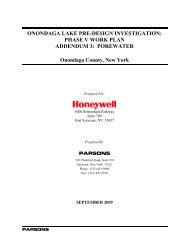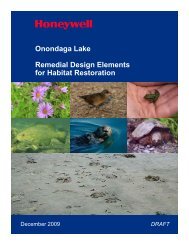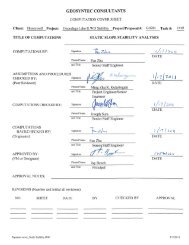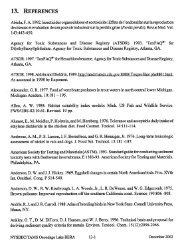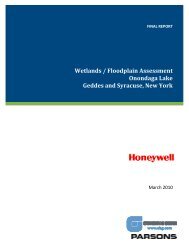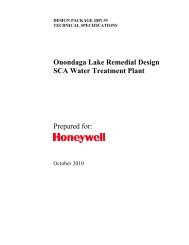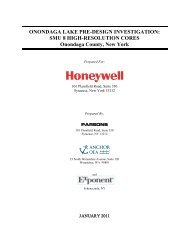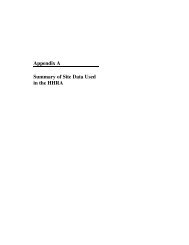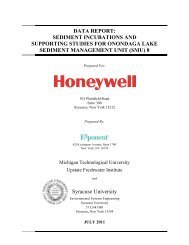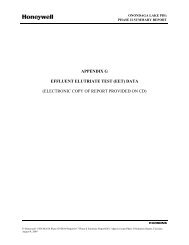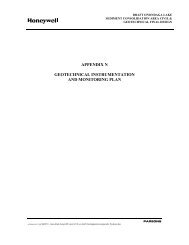Phase 1B Underwater Archaeological Report for the Onondaga ...
Phase 1B Underwater Archaeological Report for the Onondaga ...
Phase 1B Underwater Archaeological Report for the Onondaga ...
You also want an ePaper? Increase the reach of your titles
YUMPU automatically turns print PDFs into web optimized ePapers that Google loves.
FINAL<br />
<strong>Phase</strong> IB <strong>Underwater</strong> <strong>Archaeological</strong> Resources <strong>Report</strong> <strong>for</strong> <strong>Onondaga</strong> Lake Superfund Site<br />
target, and accommodated <strong>the</strong> specific underwater conditions of <strong>the</strong> site. For large area searches, <strong>the</strong><br />
diver swam parallel transects, in a back-and-<strong>for</strong>th overlapping pattern. For more localized anomalies, or<br />
<strong>for</strong> lower-visibility conditions, <strong>the</strong> diver used a circle-search survey technique swimming concentric<br />
circles, overlapping from a central point. In extremely low or zero visibility conditions, including areas of<br />
dense vegetation, <strong>the</strong> diver swung a 6ft (1.8m) fiberglass rod back and <strong>for</strong>th while swimming to ensure<br />
complete coverage of <strong>the</strong> survey area. Dive verification was also accomplished with a metal detector.<br />
Using a Fisher Pulse 8X underwater metal detector, <strong>the</strong> diver swam in one of <strong>the</strong> survey patterns<br />
described above. Metallic items exposed above <strong>the</strong> lakebed were visually examined, while buried<br />
targets were probed with a fiberglass rod to determine <strong>the</strong> size and depth of <strong>the</strong> source material.<br />
<strong>Archaeological</strong> documentation of properties dive verified in October 2010 and June 2011 was executed<br />
by taking direct measurements from <strong>the</strong> sites. The primary measuring devices were fiberglass reel tapes<br />
positioned in several locations on each site. Using multiple baselines, archaeologists recorded <strong>the</strong><br />
location of features. Small steel rulers were used to fill in details. O<strong>the</strong>r recording tools included<br />
clipboards with drafting film <strong>for</strong> writing on, staplers and awls <strong>for</strong> attaching baselines to wooden<br />
structures, and probes to determine <strong>the</strong> depth of buried remains (Figure 33). The archaeological study<br />
was non-destructive and no artifacts were recovered.<br />
The field techniques were designed to ga<strong>the</strong>r <strong>the</strong> data necessary to accurately assess <strong>the</strong> structure<br />
exposed above <strong>the</strong> sediments, and, when necessary, gage <strong>the</strong> extent of buried remains. Data was<br />
ga<strong>the</strong>red in a logical progression from general to more detailed. Documentation initially focused on <strong>the</strong><br />
structure’s overall construction plan, with later dives devoted to filling in specific construction details.<br />
The historic period boats and structures found in <strong>Onondaga</strong> Lake tended to be built using <strong>the</strong> imperial<br />
measurement system, thus all field measurements were recorded in feet and inches.<br />
High-definition video was recorded <strong>for</strong> many of <strong>the</strong> dive verified sites. The video system consisted of a<br />
Sony HDR-HC3 HDV 1080i Mini DV Handycam in a Light and Motion Blue Fin housing.<br />
The underwater recordation of field measurements and video was only <strong>the</strong> first step in <strong>the</strong><br />
documentation process. The fieldnotes were initially recorded on drafting film. After finishing <strong>the</strong> dive,<br />
archaeologists were tasked with recopying <strong>the</strong>ir field notes onto graph paper. These recopied notes<br />
were used to record observations that were too complex to note while working underwater. Scale<br />
drawings were drafted by hand on acid-fee graph paper. Additional project notes were recorded by<br />
LCMM’s <strong>Archaeological</strong> Director in <strong>the</strong> <strong>for</strong>m of a Field Log in a “Rite in <strong>the</strong> Rain”® all-wea<strong>the</strong>r notebook.<br />
Those observations are presented as Appendix 1.<br />
45



